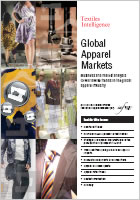Issue
2:
2nd Quarter 2008

Product Overview
Buy this Report now
Buy this Issue now
Subscribe
Download brochure (PDF)
Download price list (PDF)
Price list download
| Please choose your preferred currency:
|
Request sample issue
View list of reports
in other issues
|
Multi Report Package |
We also offer a flexible subscription product,
the Multi Report Package,
which allows you to select your own choice of reports from our full range,
to suit your own budget.
Click here for full details.
|
|
 |
Going green: policies to promote environmentally sound activities in apparel |

23 pages,
published in Issue 2, 2nd Quarter 2008
Report price:
Euro 395.00;
US$ 520.00
|
Environmental issues arise at all stages of the textile and apparel supply chain. The expansion of textile production and consumption has contributed to increasing pollution, water shortages, fossil fuel and raw material depletion, and climate change. Production of polyester fibre, the most widely used man-made fibre, consumes non-renewable resources and high energy levels, and generates atmospheric emissions. Modern automated textile plants consume large amounts of energy. Textile finishing consumes large amounts of water and energy and often produces harmful effluent. Apparel production is more environmentally friendly, but sourcing from low cost countries consumes more fuel for transportation. Among consumers, the trend towards fast fashion and cheaper clothing has led to a throw-away mentality.
Environmental issues are being addressed, however. Although recycling activity remains at a low level?for economic and quality reasons?Marks & Spencer and others are promoting recycling schemes. Some retailers are also voluntarily attaching "eco-labels" to garments to provide environmental information. Although these have met with varying levels of success in the marketplace, they can encourage "best practice" in manufacturing. Some labelling schemes, such as the EU Ecolabel Scheme and its associated flower logo, adopt a full life cycle or "cradle to grave" approach while others, such as �ko-Tex, focus on a single aspect of an item such as its environmental attributes, social attributes, or individual phases of its life cycle. Other initiatives include REACH (Registration, Evaluation and Authorisation and Restriction of Chemicals) legislation which aims to encourage safe and eco-friendly chemical production. In the USA the Toxic Substances Control Act (TCSA) enables the US Environmental Protection Agency (EPA) to track industrial chemicals produced in or imported into the country. Some man-made fibres, such as Lenzing?s lyocell fibre Tencel, have a minimal impact on the environment. Also, organic cotton production is growing rapidly but still accounts for only a small fraction of global cotton output. Nonetheless, organic cotton is being adopted by high profile companies such as C&A, Coop, Nike, Wal-Mart, and Woolworths. And a growing number of brand and manufacturing companies are pursuing environmentally friendly strategies. Such companies include American Apparel, Gap, Interface, Patagonia, and Wal-Mart in the USA as well as Rohner Textil in Switzerland, and a small knitwear company in India, MaHan, which was founded by an exteacher from the Netherlands.
|
 |
